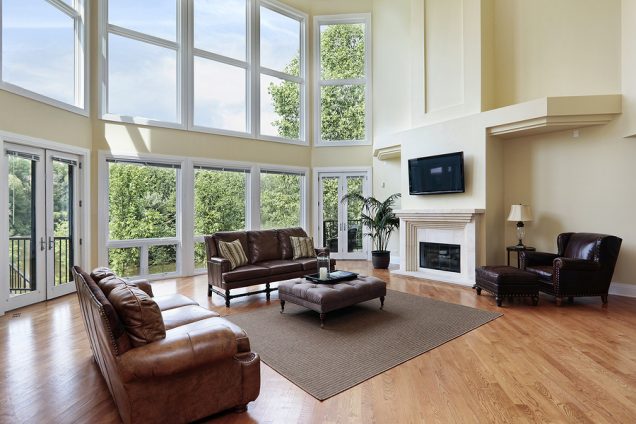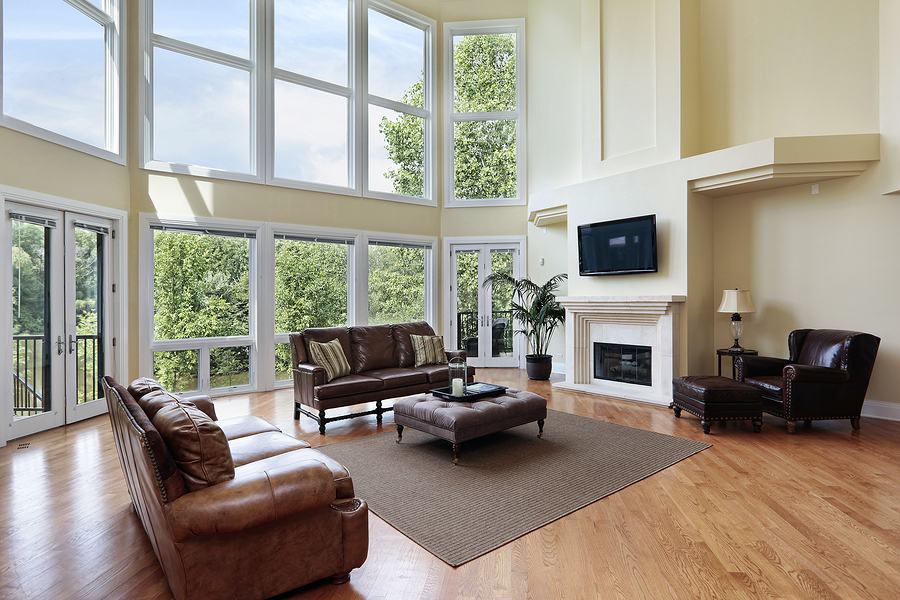What causes exterior condensation?
Exterior condensation occurs when moist air comes into contact with cool surfaces, such as glass. This type of condensation appears when the dew point in the air is higher than the temperature of the glass. This occurs when a cool night follows a warmer day, most typically during the spring and fall seasons.
How does low-emissivity (Low-E) glass affect exterior condensation?
Low-E glass reduces heat conducted through the glass from the warm interior of the home to the outside glass surface. Heat conduction can be reduced by as much as 50 percent with an efficient Low-E coated glass. This reflected heat energy reduces the outside glass temperature and can result in condensation on the glass. Exterior condensation is actually an indication that the insulating glass in the window is performing as it should.
What causes condensation on the inside glass of windows?
Whenever there is excess humidity in a home, it manifests itself in the form of condensation on the coldest area of a wall, which is normally the window. The warmer the air, the more moisture it will retain, so when air in your home comes in contact with the colder glass surface, it is subsequently cooled and moisture is released in the form of condensation on the glass.
Do windows cause condensation?
No, condensation on windows is not the fault of the window. However, by replacing drafty windows and doors or installing a new roof or siding, you are reducing air flow in your home and making it tighter. Tighter homes actually retain more humidity.
Where on a window does condensation normally form and why?
Condensation often forms at the meeting rail and at the bottom of the lower sash on the interior of the glass. This is because when warm air cools, it falls down across the interior surface of the window at the same time the temperature of the air is falling. The air contacts the horizontal surface of the meeting rail, which acts like a dam, slowing the air’s rate of fall and creating the perfect opportunity for the trapped water vapor to escape and form on the meeting rail’s surface. The air then rolls over the edge of the meeting rail and again gains speed until it encounters the lower handle of the sash. At this point, the water vapor again makes its exit and lies at the bottom of the sash.
Can I reduce the condensation on my windows?
Yes. In order to reduce condensation, humidity must be controlled and air movement must be generated. As the exterior temperature drops, the humidity level needs to decrease if condensation is to be controlled.
What steps can I take to reduce humidity in my home?
The two main things you can do are to control sources of moisture and increase ventilation. To decrease or control excess humidity and condensation:
- Use exhaust fans in your kitchen, laundry and bathrooms.
- Vent gas burners, clothes dryers, etc. to the outdoors.
- Shut off furnace humidifiers and other humidifying devices in your home.
- Be sure that the ventilating louvers in your attic, basement or crawl spaces are open and amply sized.
- Open your blinds and drapes during the day to circulate air flow.
- Open fireplace dampers to allow an escape route for moisture-laden air.
- Air out your house a few minutes each day.
Will new windows eliminate condensation?
Actually, no. Condensation is moisture vapor suspended in the air, and that’s something no one can guarantee to eliminate. However, high-quality vinyl windows incorporating warm-edge technology glazing systems will help to reduce condensation because they’re much less thermally conductive than other window types. They can help keep the temperature of the window warmer—minimizing the hot and cold differences that turn moisture into condensation.
What are the advantages of custom replacement windows over pre-made, standard-sized windows?
Because custom windows are made to fit perfectly, they provide the best energy efficiency and can be installed much more easily and with very little mess. Also, because of the myriad of options available that affect appearance and efficiency, custom windows allow consumers to get exactly the windows they need or want.
Standard windows typically cost less in the beginning, but other expenses and factors—like additional labor and the disruption to the home—far outweigh the original savings. For example, installing stock windows requires that you add brick or siding to the exterior, and drywall or other materials to the interior. In addition, custom-made windows allow you to choose the best solution to the problems you want to solve by replacing windows.
How can I tell if I need new windows?
Here are some sure signs that your old windows may need to be replaced:
- Windows rattle in the wind
- Difficulty opening them
- Drafty, with air leaking through or around the window
- Excessive condensation or icing on the inside of the window panes
- Paint chipping or peeling
- House is always too cold in the winder or too hot in the summer
What about drafts? Can new replacement windows stop them?
Drafts are caused by windows that are poorly sealed, inadequately insulated, or improperly installed. Even new replacement windows can be drafty if these areas are not addressed correctly. A quality contractor will address the insulation around the rough opening and properly insulate during installation. Good windows themselves are well insulated, and when closed and locked will effectively seal off outside air. Proper installation and the choice of window are both important, working hand in hand to effectively prevent drafts.
Window drafts can certainly be caused by the windows themselves simply being poorly built or no longer functioning properly. But even high end, energy efficient replacement window can be drafty if installation is not done with expert care. This is another reason why it is so important to locate a trustworthy, talented window contractor to do the replacement windows installation for you. Attention to detail is critical.
What makes windows energy efficient?
Energy efficient windows have a number of traits in common with one another. They are manufactured using quality frame materials that insulate well and prevent heat transfer. They have multiple panes with air or gas in the middle to insulate better.
The most energy efficient windows are those with argon or krypton between panes, gases which insulate better than air. They have low e glass to reflect infrared light and keep heat in the house during the winter. And energy efficient replacement windows have warm edge spacers to keep panes the correct distance apart. These spacers also insulate pane edges and reduce heat transfer.
What is Low-E coating?
Clear glass allows large amounts of radiant energy to pass through ~ heat in from the sun in summer, heat out from your house in winter. A low-E, or low emissivity, coating is a microscopically thin metallic film that acts something like a two-way mirror, reflecting heat back into the house in winter and blocking heat from the sun in summer. Which it does better depends on how the coating is applied. The windows can be fine-tuned for different climates, producing Southern or Northern windows, for example. Some coatings may darken the glass, like tinted glass in a car.
Is Low-E glass really worth the extra money?
Low e or low emissivity glass allows visible light to pass through a window but blocks infrared and UV light. UV light does damage to skin and furniture and causes colors to fade in carpets, couches, and other household items. And infrared light is the part of sunlight that makes objects heat up. Blocking that heat keeps surfaces in your home cool and comfortable.
Low e glass protects the members of your household and the things you own from this unwanted exposure. It also helps you save on heating costs. The same principle keeping infrared light out of your home bounces your home’s heat back off of the window surfaces and keeps it from leaving the house. Low e glass is well worth the investment. Most of the heat loss in an average home comes through the windows.
What is a Gas filled window?
Instead of air in the sealed space between glass panes, these windows use argon, krypton, or other inert gas. These gases are denser than air, so they provide better insulation.
What is Double or triple glazing?
Double-glazed windows have a sealed space between the two panes of glass, and the air in the space provides an added layer of insulation. Compared with a single pane, double glazing can cut heat loss nearly in half. The insulating value of triple-glazed windows is higher still, but the extra layer adds to weight and cost.
How can I tell if a window is energy efficient?
Check the window’s NFRC rating label. The NFRC (National Fenestration Rating Council) is an independent testing organization that rates the “U-Factor” for replacement windows. This is a measurement of the window’s ability to resist the transfer of heat and cold. U-Factor is the amount of heat transferred through a material. The lower the U-Factor, the slower the rate of heat flow, therefore the better the insulating quality.




 Let us inspect your roof's condition, repair damaged shingles, reseal flashings, replace plumbing boots, re-caulk exposed nailheads or staples, and more!
Let us inspect your roof's condition, repair damaged shingles, reseal flashings, replace plumbing boots, re-caulk exposed nailheads or staples, and more!
 Addison,
Addison,